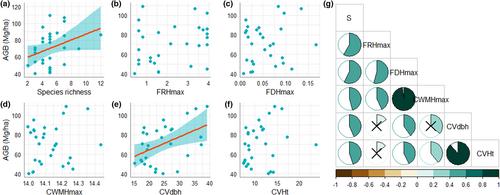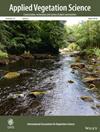Structural and taxonomic diversity predict above-ground biomass better than functional measures of maximum height in mixed-species forests
Abstract
Aims: Mixed-species forests are known to be highly productive systems because of their high species diversity, including taxonomic diversity (species richness) and structural diversity. Recent empirical evidence also points to plant maximum height, as a functional trait that potentially drives forest above-ground biomass (AGB). However, the interrelations between these biotic variables are complex, and it is not always predictable if structural diversity attributes or functional metrics of plant maximum height would act as the most important determinant of stand biomass. Here we evaluated the relative importance of structural diversity attributes and functional metrics of plant maximum height (Hmax) in predicting and mediating AGB response to variation in species richness in mixed-species forests, while also accounting for fine-scale environmental variation.
Location: Northern Benin.
Methods: We used forest inventory data from mixed-species stands of native and exotic species. We quantified structural diversity as coefficient of variation of tree diameter at breast height (CVdbh) and of height (CVHt). For plant Hmax, we computed three metrics: functional range (FRHmax), functional divergence (FDHmax) and community-weighted mean (CWMHmax). We used topographical variables such as elevation and slope to account for possible environmental effects. Simple and multiple mixed-effects models, and structural equation models were performed to assess the direct and indirect links of AGB with species richness through structural diversity attributes and functional metrics of plant Hmax.
Results: Species richness and CVdbh were positively related to AGB, while functional metrics of plant Hmax were not. Structural equation models revealed that species richness influenced AGB indirectly via CVdbh, which alone strongly promoted AGB. Elevation only had a positive direct effect on AGB. While increasing species richness enhanced CVdbh and functional measures of plant Hmax, there was no support for the latter mediating the effects of species richness on AGB.
Conclusion: Structural diversity has a significant advantage in predicting and mediating the positive effect of species richness on AGB more so than functional measures of plant Hmax. We argue that structural diversity acts as a mechanism for the species richness–AGB relationship, and that maintaining high structural diversity would enhance biomass in mixed-species forests.


 求助内容:
求助内容: 应助结果提醒方式:
应助结果提醒方式:


